Nestled atop a serene hilltop in Pokhara, Nepal, the World Peace Pagoda stands as a testament to the region’s spiritual heritage. This striking white-domed structure, built by Japanese monks in the 1970s, symbolizes the four key stages of Buddha’s life. Visitors are drawn to this tranquil site for its breathtaking views of Phewa Lake and the Annapurna mountain range, as well as the opportunity to enjoy the pagoda’s rich cultural and historical significance. But beyond its scenic splendor, the World Peace Pagoda offers a deeper exploration into the philosophical and religious underpinnings that have made it a revered destination for pilgrims and cultural enthusiasts alike.
Good To Know
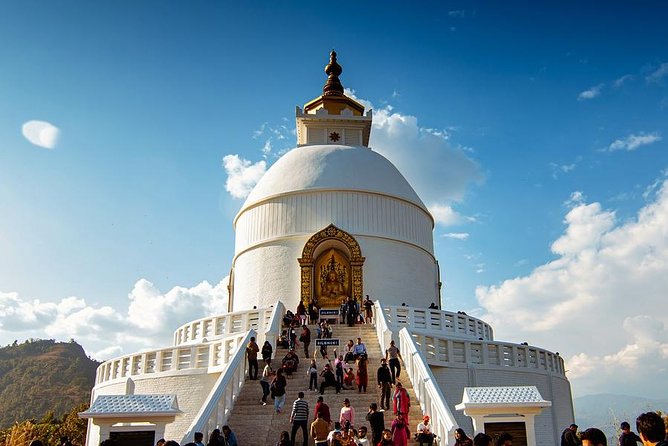
-
The World Peace Pagoda, or Shanti Stupa, is a striking white-domed structure built in the 1970s by Japanese Buddhist monks, symbolizing the four key stages of Buddha’s life.
-
The pagoda is situated on a hilltop in Pokhara, Nepal, offering breathtaking panoramic views of the Annapurna mountain range and Phewa Lake, enhancing its spiritual and scenic appeal.
-
The tour includes hotel pickup, private vehicle transport, a professional guide, admission ticket, and travel insurance, providing a comprehensive and personalized experience for visitors.
-
The site is not wheelchair accessible, and moderate walking is required, making it unsuitable for young children, but it is praised by visitors for its exceptional value and culture.
-
The pagoda’s architectural and design elements, such as the intricate carvings and harmonious blend of spirituality and natural wonder, captivate visitors and inspire them to find solace and inner calm.
Location and Significance
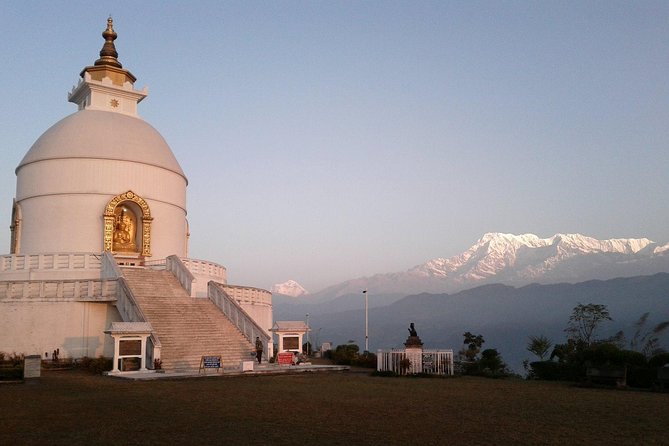
The World Peace Pagoda, also known as the Shanti Stupa, stands prominently on a hilltop in Pokhara, Nepal.
This white-domed Buddhist monument was constructed in the 1970s by Buddhist monks from the Japanese Nipponzan Myohoji order.
The pagoda’s design reflects the four key stages of Buddha’s life – birth in Lumbini, enlightenment in Bodhgaya, teachings in Sarnath, and nirvana in Kushinagar.
This symbolic representation of the Buddha’s journey makes the World Peace Pagoda a significant spiritual site, drawing pilgrims and travelers alike to appreciate its architectural beauty and serene surroundings overlooking the Phewa Lake and the Annapurna mountain range.
You can also read our reviews of more tours and experiences in Pokhara.
Tour Details and Inclusions
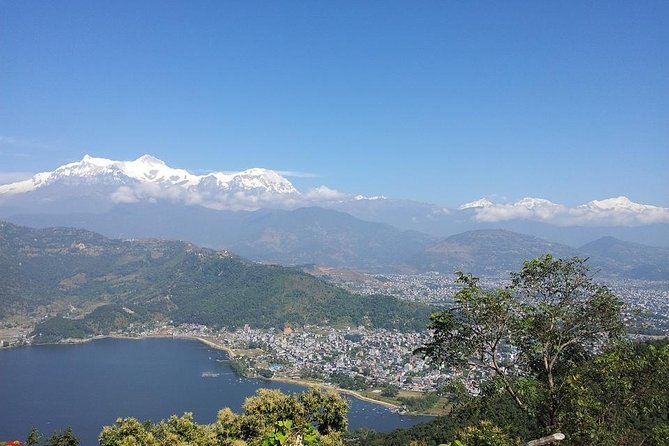
A private, personalized sightseeing tour to the World Peace Pagoda typically lasts around 3 hours. After being picked up from your hotel in Pokhara, you’ll embark on a 30-minute drive to the pagoda, followed by a 10-minute walk via staircases. The tour includes:
| Included Services | Price |
|---|---|
| Hotel pickup and drop-off | From $60.00 |
| Private vehicle transportation | Varies by group size |
| Professional tour guide | |
| Admission ticket | |
| Travel insurance |
Food and drinks are not included. Visitors should note the tour is not wheelchair accessible, and a minimum age of 5 years applies. Reviews rate the tour 5.0 out of 5, highlighting an informative and enthusiastic guide and good value for money.
Meeting and Pickup Arrangements
Where can visitors meet for the tour?
Visitors have two options to meet for the World Peace Pagoda tour. They can be picked up directly from their hotel within Pokhara city.
Alternatively, they can meet the tour guide at Barahi Chouk, a popular meeting point on Lakeside Road in Pokhara.
Regardless of the pickup location, visitors should provide their hotel name and address, as well as a local contact number, to the tour operator to coordinate the meeting and pickup arrangements.
This ensures a smooth and seamless start to the tour experience.
Accessibility and Recommendations
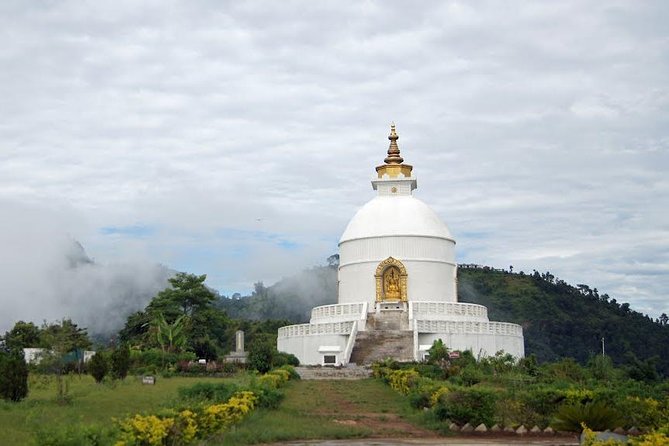
Visitors to the World Peace Pagoda should keep in mind that the site isn’t wheelchair accessible, and infants must sit on laps during the tour.
The moderate amount of walking up staircases to reach the pagoda requires comfortable shoes. Though the pagoda is a relatively easy hike, it’s not recommended for young children under 5 years old.
The site receives excellent reviews, with visitors praising the informative and enthusiastic guide as well as the good value for money.
With its stunning views and rich cultural significance, the World Peace Pagoda is a must-visit attraction for travelers to Pokhara.
Visitor Experiences and Feedback
Travelers consistently rave about the exceptional value and culture offered by the World Peace Pagoda tour. Rated 5.0 out of 5 based on 5 reviews, the tour is praised for its knowledgeable and enthusiastic guides who provide in-depth insights into the pagoda’s history and significance.
Visitors highlight the good value for money, noting the reasonable price for the personalized experience. The moderate amount of walking and picturesque views make the tour an enjoyable and memorable excursion.
Architectural and Design Elements

Atop the hill overlooking Pokhara’s shimmering Phewa Lake, the World Peace Pagoda‘s striking white-domed structure stands as a testament to Buddhist architectural elegance.
The five-tiered pagoda, built in the traditional Nepali style, features intricate carvings and ornate details that symbolize the four stages of Buddha’s life. Constructed entirely of white marble, the pagoda’s design radiates a serene and peaceful ambiance, complementing the stunning natural landscape.
Visitors can admire the pagoda’s architectural beauty while taking in the breathtaking panoramic views of the Himalayas. The pagoda’s design and location create a harmonious blend of spirituality, artistry, and natural wonder that captivates all who visit.
Historical Background and Construction
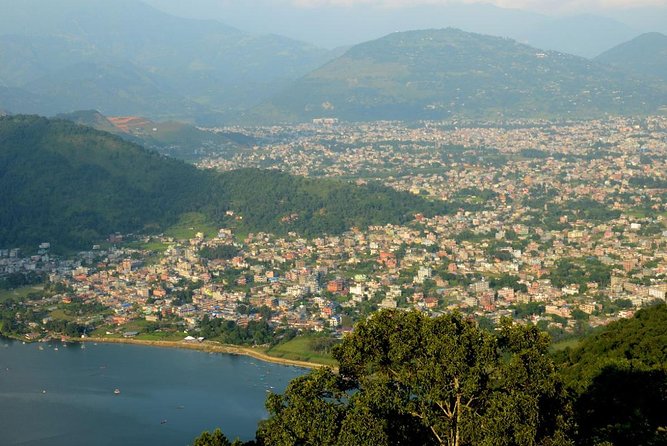
The World Peace Pagoda‘s origins trace back to the 1970s when Buddhist monks from the Japanese Nipponzan Myohoji order undertook the ambitious project of constructing this iconic landmark in Pokhara, Nepal.
Inspired by the principles of peace and non-violence, the monks chose the serene Annapurna foothills as the site for their stupa. Over several years, they meticulously constructed the pagoda, which reflects the four key stages of Buddha’s life – birth, enlightenment, teachings, and nirvana.
Completed in the late 1970s, the striking white structure has since become a beloved symbol of Pokhara, attracting visitors from around the world who seek spiritual enlightenment and a deeper connection with Buddhist philosophy.
Spiritual and Cultural Relevance

Perched atop Annapurna’s foothills, the World Peace Pagoda stands as a revered symbol of Buddhist philosophy and cultural heritage.
Constructed by Japanese Buddhist monks, the pagoda’s four stages reflect the life of Buddha – from birth to enlightenment, teachings, and nirvana.
The gleaming white structure serves as a beacon for devotees and visitors alike, offering a serene space for meditation and contemplation.
Its towering presence overlooks the picturesque Phewa Lake, creating a harmonious fusion of spiritual and natural elements.
As a testament to the principles of peace and unity, the World Peace Pagoda inspires all who venture here to find solace and inner calm amidst the grandeur of the Himalayas.
Frequently Asked Questions
Can I Take Pictures Inside the Pagoda?
Yes, visitors can take photos inside the pagoda. It’s encouraged to capture the impressive architecture and cultural significance of this site during the tour.
Are There Any Dress Code Requirements to Enter?
There are no strict dress code requirements to enter the World Peace Pagoda. Visitors should wear modest, comfortable clothing that covers the shoulders and knees. Exposing too much skin is generally discouraged out of respect for the sacred site.
How Long Does the Round-Trip Journey Typically Take?
The round-trip journey typically takes around 3 hours. It includes a 30-minute drive to the pagoda, a 10-minute walk via stairs, and ample time to explore the site before returning to the pickup location.
Are There Any Restroom Facilities Available On-Site?
Yes, there are restroom facilities available on-site for visitors to the World Peace Pagoda. The facilities are well-maintained and easily accessible during the tour of the pagoda.
Can I Purchase Souvenirs or Religious Items at the Pagoda?
Yes, visitors can purchase souvenirs and religious items at the World Peace Pagoda. There are stalls selling a variety of Buddhist-themed merchandise, including statues, prayer beads, and handicrafts for visitors to browse and purchase during their visit.
Sum Up
The World Peace Pagoda in Pokhara, Nepal is a breathtaking spiritual site that offers visitors a serene space for reflection and culture. Symbolizing the key stages of Buddha’s life, the pagoda’s white-domed structure and panoramic views of the Annapurna range make it a must-visit destination for those seeking a meaningful and visually stunning experience in Nepal.
More Tour Reviews in Pokhara
Not for you? Here's more things to do in Pokhara we have recnetly reviewed
- 2 Best Dining Experiences In Pokhara
- 20 Best 2 Day Tours In Pokhara
- 2 Best Dinner Tours In Pokhara
- 20 Best 3 Day Tours In Pokhara
- 20 Best 4 Day Tours In Pokhara
- 8 Best Cruises And Boat Tours In Pokhara
- 20 Best Full-Day Tours In Pokhara
- 16 Best Helicopter Flights And Tours In Pokhara
- Best 4 Day Tours In Naya Pul
- 7 Best Massage And Relaxation Services In Pokhara
- 6 Best Photography Experiences In Pokhara
- Ghorepani Poonhill Trek
